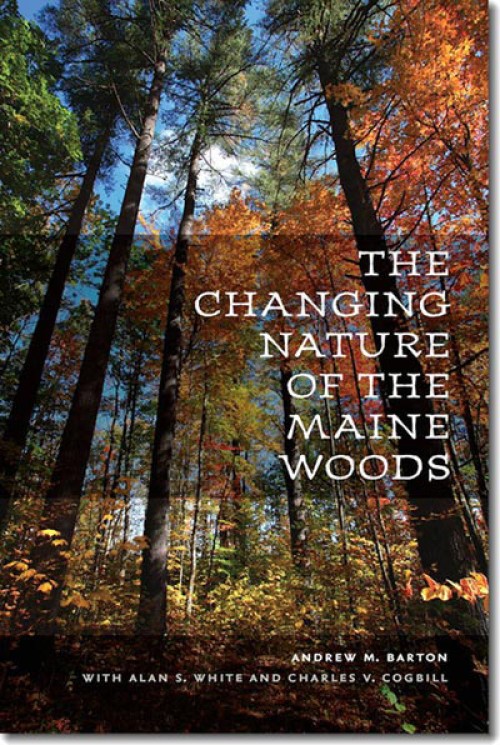by Andrew M. Barton with Alan S. White and Charles V. Cogbill
University of New Hampshire Press, 2012
One thing that still amazes me about living and working in Maine is the amount of ecological diversity one can find in a fairly small area. The other day, I came across a black spruce stand in the southernmost corner of the state where I would have expected red spruce to be growing. The glacial outwash plain, covered with a dense rank of uniform, small-crowned conifers, reminded me more of forests I have seen in central Labrador than anything I have witnessed in Maine, save for a few locations near the St. John River near Quebec. Only the white carpet of caribou lichen and swarms of midsummer black flies were missing.
And yet this site is only 10 miles from Maine’s Mount Agamenticus, which Drew Barton and his co-authors in The Changing Nature of the Maine Woods describe as being more reminiscent of southern New England, or even Virginia. At Mount Agamenticus, one can find a temperate deciduous hardwood forest with species such as chestnut oak, shagbark hickory, sweet birch, sassafras, and mountain laurel.
The Changing Nature of the Maine Woods traces the history of Maine’s forests from the end of the last ice age through the present, describes current forest conditions, and offers a glimpse at changes that may occur in the future. Pollen grains found in peat bog cores indicate that spruce, which is characteristic of Maine’s northern and maritime forests, was abundant shortly after the glaciers receded, but then virtually disappeared about 10,000 years ago, only reappearing about 1,000 years before the present as the earth’s climate suddenly cooled. At the same time spruce disappeared, white pine appeared and soon became much more plentiful than it is today. Significant amounts of charcoal in lake sediments when white pine was most abundant suggest a warm, dry climate and frequent forest fires caused by lightning. Maps, charts, and text describe how the major species that comprise Maine’s forests today have come and gone over time and migrated at different speeds and in different patterns across the landscape of eastern North America since the end of the last ice age.
Charles Cogbill’s database of over 23,000 witness trees that were noted in land surveyor’s records provides a picture of what tree species were found across the state at the time of European settlement. The authors use this information and data from the few remnants of oldgrowth forest as benchmarks in their review of forest changes from the Colonial era to the present. Unlike most of New England, Maine’s forests were never extensively cleared for agriculture, so the ecological and human history account is different than that of neighboring states.
Looking forward, the book covers the factors that contribute to the diversity of Maine’s ecoregions today, and discusses potential changes due to acid rain, land-use change, climate change, and what the authors call a “rogues gallery” of invasive insects, pests, and diseases.
The book is more than a simple compilation of the changes in Maine’s forests over time. The authors show how scientific thinking has evolved and why some debates are still far from settled, such as the debate over what caused the sudden disappearance of the late Pleistocene “megafauna.” The authors have distilled information from hundreds of scientific sources and decades of professional experience and presented the synthesis in an easy-to-read narrative that readers without technical expertise will enjoy. However, this book is sufficiently detailed that forest professionals will also find it well stocked with useful information.


